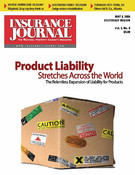We have all seen them, those annoying stickers on everything we buy warning us: This bag is not a toy; and this or that small object is a chocking hazard. As if left to our own devices, we would all be giving our children plastic bags for Christmas and encouraging toddlers to teeth on dime-sized objects.
In today’s society, we are no longer expected to have any common sense, to know that plastic film can suffocate or that small objects are likely to end up in a child’s mouth if he or she is not properly supervised.
The question you may ask is: How did we come to such a state? The answer: Slowly.
Liability laws evolved over time
The law of products liability, like most concepts in our system of jurisprudence evolved over time. The original common law concept was caveat emptor, a Latin phrase which means simply “let the buyer beware.” It was the purchaser’s responsibility to make sure that the product he bought was safe and effective for his intended use. This gave way to implied warranties of merchantability and fitness for a particular purpose, especially in situations in which a buyer explained what he was trying to do and let the craftsman supply the solution.
All these concepts dated from a time when one would actually deal with a craftsman face-to-face. Buyers and sellers were in direct contact, and the law of contracts could be successfully applied. The industrial revolution changed all that.
Once processes became mechanized, we normally didn’t have direct dealings with the makers of our goods. Most products were sold through merchants, who probably got them from distributors. This sea of change in the way things were done left contract law out in the cold. To enforce a contract, a judge must find something known as “privity,” a legal concept directly linking the injured party to the defendant. Without privity, no right of recovery could be sustained.
Negligence standard
Since more often than not people injured by defective products had no direct contact with the maker of the product, the law reached into its quiver and pulled out the concept of “negligence.” Under this theory, if one could prove a product was unsafe due to the maker’s negligence, recovery was allowed despite lack of contractual privity.
The negligence standard was but a brief stepping stone on the path to our ultimate destination: “strict liability.” Most legal scholars trace this quantum leap of jurisprudence to Justice Traynor’s concurrence in Escola v. Coca Cola Bottling Co. (24 Cal. 2d 453, 150 P.2d 436 (1944)). In that case a waitress was injured when a Coca Cola bottle exploded. Justice Traynor asserted that even if negligence per se could not be proven, the plaintiff deserved to be compensated for her injuries because, “as a matter of public policy,” the manufacturer was in the best position to inspect for and anticipate dangers of the product and (here comes the quantum leap) the best position to allocate the cost of those dangers. In that one decision our modern concept of products liability was born. No question of fault, just injury and recovery.
Certainly the concepts have been refined, stretched, distorted, even taken to new highs or lows by ensuing case law and scholarly works such as the Restatement of Torts, but that is the thing is a nutshell. The manufacturer is supposed to include the cost of making people whole for any injury from the use of the product into the product’s price.
That may sound like an efficient solution, even equitable, but trial lawyers have expanded this premise to the point that it is very difficult to forecast what costs to include.
Three types of claims
We now have three types of product liability claims: design defect, manufacturing defect and information defect.
The first two are fairly straight-forward. The manufacturer should have found a safer design, if not, they made a mistake in the manufacturing process which resulted in a flawed product. The third is the most active and interesting and the cause of all those annoying labels.
Some products are considered inherently dangerous, even though their design and manufacture are beyond reproach. Therefore it is incumbent on the manufacturers to warn us of these dangers of use, misuse and abuse. The problem arises in that it is becoming easier to claim this sort of defect with all sorts of products. This is what makes it possible to sue a restaurant for not warning us that their coffee is hot, or a gun maker because a gun actually shoots a bullet when its trigger is pulled.
Some of these suits are successful others fail. They all drive up the cost of the goods and services we buy because all those potential costs need to be priced into the product: Litigation expense if nothing else, and of course, add in whatever it costs to print all those silly labels. Remember, they wouldn’t be there if no one thought they were necessary.
In 1996, Sherrill entered the insurance business as a principal at Sherrill & Company, an independent insurance agency in Savannah, Ga. He previously practiced construction industry law with Shaw, Pittman, Potts & Trowbridge in Washington, D.C. Sherrill can be reached at sherrill@sherrilandcompany.com.
Topics Manufacturing
Was this article valuable?
Here are more articles you may enjoy.


 Cargo Owners in Baltimore Disaster Face ‘General Average’ Loss Sharing, MSC Says
Cargo Owners in Baltimore Disaster Face ‘General Average’ Loss Sharing, MSC Says  Harvard Study Again Stirs the Pot on Demotech Ratings of Florida Carriers
Harvard Study Again Stirs the Pot on Demotech Ratings of Florida Carriers  California Sees Two More Property Insurers Withdraw From Market
California Sees Two More Property Insurers Withdraw From Market  USAA to Lay Off 220 Employees
USAA to Lay Off 220 Employees 


